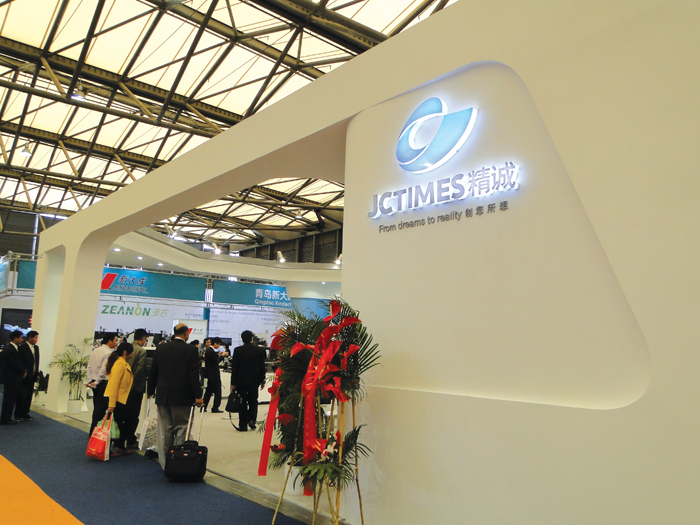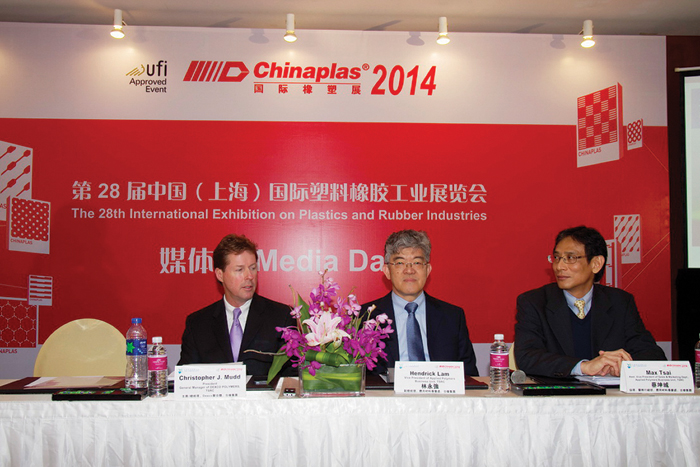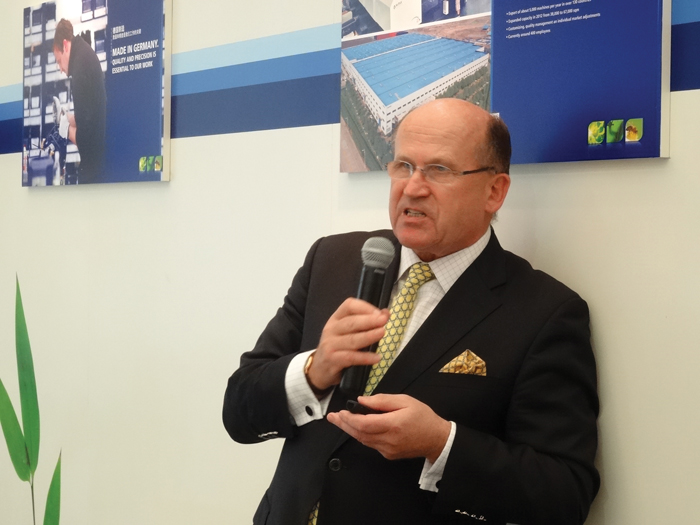What’s New in the Chinese Plastics Industry
Chinaplas® 2014 was a gateway to China’s most innovative materials & machinery suppliers
Previous Article Next Article
By Dennis Duan
China Plastic & Rubber Journal
What’s New in the Chinese Plastics Industry
Chinaplas® 2014 was a gateway to China’s most innovative materials & machinery suppliers
Previous Article Next Article
By Dennis Duan
China Plastic & Rubber Journal
What’s New in the Chinese Plastics Industry
Chinaplas® 2014 was a gateway to China’s most innovative materials & machinery suppliers
Previous Article Next Article
By Dennis Duan
China Plastic & Rubber Journal

JCTIMES’s booth at Chinaplas 2014

JCTIMES’s booth at Chinaplas 2014
“A few years ago, China’s injection molding sector had taken the steps to develop all-electric machines. At this year’s show, a lot of them have set sights on creating solutions for specialty applications.”

Christopher J. Mudd (left), president and general manager of Dexco, explained the company’s strategy at the Chinaplas 2014 Media Day.

Christopher J. Mudd (left), president and general manager of Dexco, explained the company’s strategy at the Chinaplas 2014 Media Day.
“In-mold labeling (IML) is not uncommon among extrusion blow molding machines, but it is the opposite case in injection blow molding."

Professor Helmar Franz, executive director and Chief Strategy Officer at Haitian International.

Professor Helmar Franz, executive director and Chief Strategy Officer at Haitian International.
“China’s plastics processing industry… is now a modern manufacturing industry which utilizes new materials, new crafts, new technologies, and new equipment."
The development of China’s plastics industry was under the spotlight at Chinaplas 2014. Not only are Chinese processors looking for high-quality equipment, materials and machinery suppliers in the country are also paying great attention to environmental friendliness, safety, and efficiency.
Thermoplastic Elastomers: A Red-Hot Property
Thermoplastic elastomer (TPE) is seen as a next-generation material that can substitute for rubber and polyvinyl chloride (PVC), which is why it has become one of the hottest markets.
TSRC Corporation announced that its new production facility in the city of Nantong has already commenced, with an annual capacity of 25,000 tons. The major product is its Vector styrene-isoprene-styrene (SIS) triblock copolymer. The company is also planning to form a joint venture (JV) with CPC Corporation, with the aim of building another SIS site in Taiwan that adds 30,000 tons capacity a year.
As Christopher J. Mudd, president and general manager of Dexco, a company of TSRC, explains, “The global demand for SIS is around 300-400 kiloton[s] and is growing faster than GDP by two times.” (Dexco is a U.S. joint venture between ExxonMobil and Dow that was acquired by TSRC in 2011.)
LCY Chemical Group has rolled out its new line of “green” material, Globalene thermoplastic vulcanizate (TPV). Its Globalene 1000 and 4000 series are crosslinking TPVs based on ethylene propylene diene monomer (EPDM), which can be used as a replacement for EPDM, chloroprene rubber, and other synthetic rubber.
As introduced, the material has superior compression set resistance and compression stress relaxation, in addition to a soft touch. Its high heat resistance, at 135°C, is particularly suitable for sealing applications.
“We offer a broad range of TPVs that can be used to substitute rubber. Our comprehensive solutions will allow us to grow hand in hand with customers,” says Ostin Tan, senior director, Performance Composite Business, LCY Chemical Group.
Environmentally Friendly Additives under the Spotlight
The safety of plastics is closely related to additives and modifiers. Environmentally friendliness, safety, and halogen-free formulations are the current market requirements.
Beijing Tiangang Auxiliary Co. Ltd. presented a series of additives against materials aging, such as hindered-amine light stabilizers (HALS), UV absorbers, and other high performance products for coatings. According to Beijing Tiangang deputy general manager Liu Gang, the market is demand higher quality products that offer better anti-aging properties.
“Plastics products without add[ed] light stabilizers are more prone to deterioration. Especially in the past two years, customers are looking for plastics materials that can resist aging; therefore the demand for light stabilizers and UV absorbers are increasing and more efforts are being put into R&D,” he says.
Beijing Tiangang currently operates two sites, one in Beijing and another in Hebei province. The latter, completed in 2011, has an annual capacity of 10,000 tons of light stabilizer. It is said to be one of the largest production bases in Asia.
Polyrocks Chemical Co. Ltd. is a Chinese halogen-free flame retardants (HFFR) supplier founded in 2007. In addition to HFFR, the company also developed frame retardant TPE and thermoplastic polyurethane products.
Yang Zhenggao, Plastics Division General Manager at Polyrocks Chemical, talked about the company’s strategy. “Our focus will be on the automotive industry, developing products particularly for electric vehicles. Our R&D department has already started research for car parts.”
Injection Molding Continues a Rising Trend
A few years ago, China’s injection molding sector had taken the steps to develop all-electric machines. At this year’s show, a lot of them have set sights on creating solutions for specialty applications.
At Chinaplas 2014, Haitian International’s Zhafir Plastics Machinery presented its new electric machines, Zeres, for the first time. Zeres is an injection molding machine based on electric technology and equipped with an integrated hydraulic unit that is developed by Zhafir, offering high flexibility for plastics processors. The series offers a clamping force between 400 and 2300kN.
“The introduction of the Zeres series enables plastics processors to turn to electric machines with ease. The machine ensures high accuracy and repeatability that are common features of high quality optical products,” explains Zhang Jianfeng, executive director and China sales director of Haitian.
A ZE1900 was shown at the show, demonstrating the production of automotive part made of polyamide-6 reinforced with 30% glass fiber. According to Haitian, Zeres allows customers who still operate a lot of molds with hydraulic core pulls to comfortably use these molds and benefit from the advantages of electric machines, such as high precision and easy maintenance.
Regarding Haitian’s future development, Helmar Franz, executive director and Chief Strategy Officer, said two new facilities are under construction which will in the future produce all-electric machines and large two-platen injection machines.
Tederic Machinery presented four machines at Chinaplas that represented its R&D trends and directions, including two-platen clamping technology, all-electric injection molding technology, dual-stage-type extrusion injection molding technology, PP high-speed thin-wall molding technology, and electro-hydraulic energy efficient technologies, as well as a new generation of injection molding machine control technology.
Yue Qinyang, administrative director at Tederic, says, “A major feature of our two-platen injection molding machine is the proprietary self-balancing clamping system. With an intelligent control unit, it ensures that the power is evenly distributed among the four tie-bars, so that mold movement and clamping procedure runs smoothly. Both the speed and precision of the machine is raised while waste products are reduced.”
Yue added that the special injection unit of Tederic allows high volume injection, which is tailored for the manufacture of medium to large parts for construction or pipe industries.
The developments of Guangdong Yizumi Precision Machinery Co. Ltd. focus on the requirements of special market segments: better quality, faster cycle time, greater stability, and quicker response. One of its exhibits is a thin-wall injection molding machine, PAC300, tailored specifically for the packaging industry. Its applications include thin-walled containers and bottle caps, as well as medical devices.
At the show, Yizumi demonstrated the production of 1000-mL thin-wall fast-food containers. Equipped with a servo take-out robot, the total cycle time, including robot extraction time, is within six seconds. Yizumi says the machine offers high efficiency, stability, energy saving and cleanliness, which can improve the raising the input-output ratio for plastics processors.
By providing a complete solution that includes mold and other auxiliary equipment, Yizumi is committed to setting a trend in the industry: the transition from extensive development to intensive development.
The FCS Group brought to Chinaplas the A-PACK In-Mold Labeling “turnkey solution,” a two-component injection molding machine (the FB-SV Series, and a two-platen “hydra-mech” injection molding machine (the LN-SV Series).
Jerry Wang, general manager of FCS (Ningbo) Machinery Manufacture Co. Ltd, says, “The signature product has to be our hydra-mech injection molding machines (LN series). This is a solution we have been developing in Taiwan for eight years, and as we see the Chinese market is becoming more mature, it is now being produced in our Ningbo and Dongguan factory for cost-effectiveness.”
This type of machine is getting smaller, he noted, because land is getting more expensive, and a smaller footprint essentially means lower production cost and higher price-to-performance ratio.
Multiplas demonstrated at Chinaplas 2014 an intelligent automatic production system producing two-color screwdrivers. The whole system comprises two vertical and one horizontal injection molding machine to achieve two-color injection and production of a package box. The shaft is moved to the first station and injection molded with the first color by a C3-2R-55T vertical injection machine with rotary table. It is then moved to the second station, where a V4-S-55T vertical machine injects the second color.
The third station, with a SM-90T horizontal injection machine, is responsible for the production of package box. After a CCD image quality check, the screwdriver is packed by robotic arms.
“The demand for production cells is rising, especially automatic lines without the need of labor,” reflects David Wu, general manager of Multiplas Enginery Co. Ltd.
More Efficient Extrusion Lines
Efficiency and functional integration are two major characteristics of competitive extrusion lines. At Chinaplas, Chinese suppliers passed these two marks with flying colors.
Shanghai Jwell Machinery presented its latest technology for sheet, pipes, and profiles production. Automation is a feature throughout its high performance extrusion line, which can be seen in automatic diameter changing, wall thickness inspection, and weighing.
Other highlights of Jwell were its wood-plastic composite (WPC) extrusion line, for example, single screw PVC (foamed) line, and one-step PVC extrusion line.
Everplast Machinery Co. Ltd. also brought to Chinaplas its WPC line, as well as chlorinated PVC (CPVC) compounding line and three-layer pipe system. About its exhibits, Kenny Chen, general manager of Everplast, said the highlight was the CPVC compounding system, because it is a material that offers strong potential and is only starting to grow in China. CPVC offers stronger corrosion resistance at elevated temperatures than PVC. Moreover, CPVC is easier to process compared to PVC and polyvinyl butyral (PVB) because of their high viscosity.
Tianjin Hengrui Plastic Machinery Co. Ltd. manufactures extrusion lines for films and sheets, as well as related auxiliary equipment. According to Wei Liguo, general manager of Hengrui, one of the highlights of the show was its polymethyl methacrylate (PMMA) sheet line, with a width between 1000 and 2200 mm, thickness 0.5-10 mm, and length of 850 mm. Its extrusion rate was between 500 and 1000kg/hr. He added that there is a vast improvement in production volume, and, along with higher automation, it’s suitable for mass production.
One of the major exhibits of Jingcheng Times Group (JCTIMES) was its newly developed thin-gap coating dies, which, with its rheological analysis technology and unique flow channel design, can guarantee uniformity and stability. It’s suitable for all kinds of hot-melt products, and can be equipped horizontally or vertically downwards to adjust optimally with the barrel.
In addition, the company also presented its hollow sheet dies designed for eco-friendly PC+UV construction materials as well as PVC foam sheet dies, which contribute to material saving and higher quality product.
According to the company, the RMB 200 million new production site will begin operation in the second half of this year, making it one of the biggest extrusion die manufacturing sites in the world.
Changzhou Changlang Gearbox Co. Ltd. manufactures gearboxes for co-rotating parallel twin-screw extruders, counter rotating parallel twin-screw extruders, as well as single screw extruders. Its general manager, Cheng Xiangyang, says, “The specific torque of our gearbox for counter-rotating parallel twin-screw extruders can reach 25.03 Nm/cm3, which allows us to compete against the best of the world.”
Another new product is its DSW series high-torque single-screw extruder gearbox, offering three-level deceleration. The power range ratio is between 6.3 and 45.
Higher Performance Injection Blow Molding
In-mold labeling (IML) is not uncommon among extrusion blow molding machines, but it is the opposite case in injection blow molding.
Jiangsu Victor Machinery Co. Ltd. introduced its PP/PE injection blow molding IML system at Chinaplas 2014. “IML is now a common installation in injection molding or extrusion blow molding applications. We are the first company in China to put it into an injection blow molding machine,” says Gao Song, general manager.
According to Gao, the system performs labeling functions on a blow-molded bottle in only 1.5-2 seconds, with a daily production capacity of 23,000 bottles. “Not only [does] it save space and human resources, the automated system also vastly improves production efficiency with high quality labeling, a must for those who want to enhance the corporate image.”
Auxiliary Equipment: Winning Industry’s Confidence
Improvements of Chinese machinery is not only limited to molding machines, but applies also other equipment as well. Chinese auxiliary equipment manufacturers have gradually become a force for the world to reckon with.
Shanghai Sonner Machinery Co. Ltd. brought to Chinaplas a variety of new products. “Many of our standard equipment [auxiliaries] are now installed with improved control systems. In addition, we have developed new products like [a] small feeder for laboratory work, conveying system for powder material, as well as the M250 industrial computer controller,” notes Eric Peng, Sonner’s general manager. The M250 industrial computer controller, as introduced, is able to control up to 20 Sonner loss-in-weight gravimetric dosing systems through its EC-LW control module.
Peng emphasized that Sonner aims to become a truly global player. “There is no difference between Sonner in China and any other regions. We are not calling them our subsidiary. We just have different responsibilities in different areas,” he explains.
Happyway Automation Co. Ltd. introduced two new web inspection systems (WIS) in Shanghai. The visual system performs 100% real-time inspection and displays and identifies all surfacing defects of web products as small as 0.1 mm. It is also capable of sorting different types of defects and performing reports and analysis. According to Wang Hairong, senior sales manager of Happyway Automation, the new WIS system can be used on extruded films, cast films, calendared films, blown films, composites, rubber, and non-wovens.
Note:
This article first appeared in China Plastic & Rubber Journal.